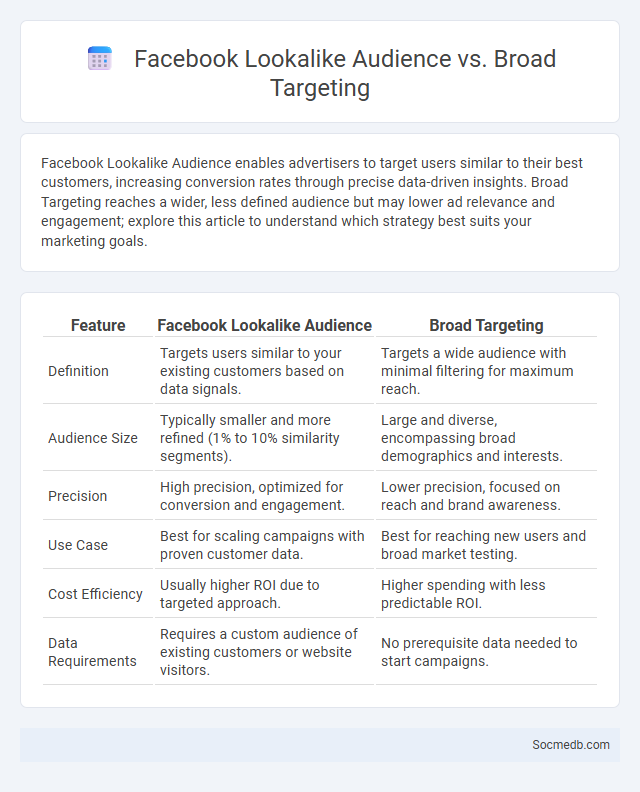
Photo illustration: Facebook Lookalike Audience vs Broad Targeting
Facebook Lookalike Audience enables advertisers to target users similar to their best customers, increasing conversion rates through precise data-driven insights. Broad Targeting reaches a wider, less defined audience but may lower ad relevance and engagement; explore this article to understand which strategy best suits your marketing goals.
Table of Comparison
| Feature | Facebook Lookalike Audience | Broad Targeting |
|---|---|---|
| Definition | Targets users similar to your existing customers based on data signals. | Targets a wide audience with minimal filtering for maximum reach. |
| Audience Size | Typically smaller and more refined (1% to 10% similarity segments). | Large and diverse, encompassing broad demographics and interests. |
| Precision | High precision, optimized for conversion and engagement. | Lower precision, focused on reach and brand awareness. |
| Use Case | Best for scaling campaigns with proven customer data. | Best for reaching new users and broad market testing. |
| Cost Efficiency | Usually higher ROI due to targeted approach. | Higher spending with less predictable ROI. |
| Data Requirements | Requires a custom audience of existing customers or website visitors. | No prerequisite data needed to start campaigns. |
Introduction to Facebook Audience Targeting
Facebook Audience Targeting enables marketers to precisely reach specific demographics based on interests, behaviors, location, and more. By leveraging Facebook's vast user data, advertisers can create customized campaigns that improve engagement and conversion rates. Advanced targeting options include custom audiences, lookalike audiences, and detailed demographic filters to maximize ad effectiveness.
What is a Lookalike Audience on Facebook?
A Lookalike Audience on Facebook is a targeted advertising feature that allows you to reach new users who share similar characteristics with your existing customers or followers. Facebook uses data from a source audience, such as your website visitors or email list, to identify patterns and find people with comparable interests, behaviors, and demographics. This tool helps your business expand its reach and improve ad performance by focusing on individuals most likely to engage with your content.
What is Broad Targeting on Facebook?
Broad targeting on Facebook refers to an advertising strategy where you reach a large and diverse audience without applying narrow criteria such as specific demographics, interests, or behaviors. This approach allows Facebook's algorithm to optimize delivery dynamically, aiming to find the most relevant people who are likely to engage with your ad or convert. Using broad targeting can increase your campaign's reach and discover new potential customers beyond your usual audience parameters.
Key Differences Between Lookalike Audience and Broad Targeting
Lookalike Audience targets users who closely resemble your existing customers based on data such as demographics, interests, and behaviors, maximizing conversion potential through precise matching algorithms. Broad Targeting casts a wider net by reaching a large, diverse audience without specific filters, suitable for brand awareness and new market exploration. Understanding these key differences enables you to optimize your social media campaigns effectively, balancing precision and reach for better results.
Benefits of Using Lookalike Audiences
Lookalike Audiences enable advertisers to reach new potential customers who share similar characteristics with their existing audience, increasing the likelihood of engagement and conversion. By leveraging Facebook's algorithm and user data, your campaigns can be more targeted and efficient, resulting in higher ROI and improved ad performance. This approach helps you expand your reach while maintaining relevance, ensuring your marketing budget is spent on users who are most likely to be interested in your products or services.
Advantages of Broad Targeting on Facebook
Broad targeting on Facebook allows your ads to reach a diverse and extensive audience, increasing brand awareness and potential customer acquisition across various demographics and interests. This approach leverages Facebook's vast user data and advanced algorithms to optimize ad delivery, enhancing engagement and conversion rates without the need for precise segmentation. By utilizing broad targeting, you can efficiently test different market segments and discover unexpected audiences that drive business growth.
When to Use Lookalike Audience vs Broad Targeting
Lookalike Audiences excel when targeting users similar to your existing customers, maximizing conversion potential with precise demographic and behavioral attributes. Broad Targeting suits campaigns aiming for wide reach and brand awareness, allowing algorithmic optimization to identify high-performing segments over time. Choosing Lookalike Audiences sharpens Your advertising efficiency, while Broad Targeting enhances scalability and data collection in early-stage marketing.
Limitations of Lookalike Audiences
Lookalike Audiences on social media platforms offer powerful targeting by finding users similar to your existing customers, but they have limitations such as potential privacy concerns and reduced accuracy in niche markets. Their effectiveness relies heavily on the quality and size of your seed audience, and smaller or less diverse sources can lead to less relevant matches. You must carefully monitor performance metrics and adjust strategies to overcome these inherent challenges in lookalike targeting.
Challenges of Broad Targeting Strategies
Broad targeting strategies on social media often struggle with audience oversaturation, leading to decreased engagement rates and wasted ad spend. Difficulty in accurately segmenting diverse user interests results in messages that lack personalization and relevance. These challenges increase the risk of lower conversion rates and reduced return on investment for brands.
Best Practices for Choosing the Right Facebook Targeting Approach
Effective Facebook targeting hinges on understanding your ideal audience by analyzing demographics, interests, and online behaviors to maximize ad relevance. Utilizing Facebook's Custom Audiences and Lookalike Audiences enhances precision by retargeting engaged users and expanding reach to similar profiles. Regularly testing and refining targeting parameters based on performance metrics optimizes ad spend and boosts campaign ROI.
 socmedb.com
socmedb.com